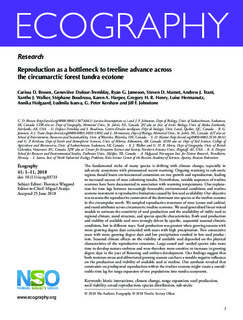Reproduction as a bottleneck to treeline advance across the circumarctic forest tundra ecotone
Brown, Carissa D.; Dufour-Tremblay, Geneviève; Jameson, Ryan G.; Mamet, Steven D.; Trant, Andrew J.; Walker, Xanthe J.; Boudreau, Stephane; Harper, Karen A.; Henry, Grepory H.R.; Hermanutz, Luise; Hofgaard, Annika; Isaeva, Ludmila; Kershaw, G. Peter; Johnstone, Jill F.
Journal article, Peer reviewed

Åpne
Permanent lenke
http://hdl.handle.net/11250/2559512Utgivelsesdato
2018Metadata
Vis full innførselSamlinger
- Publikasjoner fra CRIStin - NINA [2364]
- Scientific publications [1392]
Originalversjon
10.1111/ecog.03733Sammendrag
The fundamental niche of many species is shifting with climate change, especially in sub-arctic ecosystems with pronounced recent warming. Ongoing warming in sub-arctic regions should lessen environmental constraints on tree growth and reproduction, leading to increased success of trees colonising tundra. Nevertheless, variable responses of treeline ecotones have been documented in association with warming temperatures. One explanation for time lags between increasingly favourable environmental conditions and treeline ecotone movement is reproductive limitations caused by low seed availability. Our objective was to assess the reproductive constraints of the dominant tree species at the treeline ecotone in the circumpolar north. We sampled reproductive structures of trees (cones and catkins) and stand attributes across circumarctic treeline ecotones. We used generalized linear mixed models to estimate the sensitivity of seed production and the availability of viable seed to regional climate, stand structure, and species-specific characteristics. Both seed production and viability of available seed were strongly driven by specific, sequential seasonal climatic conditions, but in different ways. Seed production was greatest when growing seasons with more growing degree days coincided with years with high precipitation. Two consecutive years with more growing degree days and low precipitation resulted in low seed production. Seasonal climate effects on the viability of available seed depended on the physical characteristics of the reproductive structures. Large-coned and -seeded species take more time to develop mature embryos and were therefore more sensitive to increases in growing degree days in the year of flowering and embryo development. Our findings suggest that both moisture stress and abbreviated growing seasons can have a notable negative influence on the production and viability of available seed at treeline. Our synthesis revealed that constraints on predispersal reproduction within the treeline ecotone might create a considerable time lag for range expansion of tree populations into tundra ecosystems. biotic interactions, climate change, range expansion, seed production, seed viability, sexual reproduction, species distribution, sub-arctic